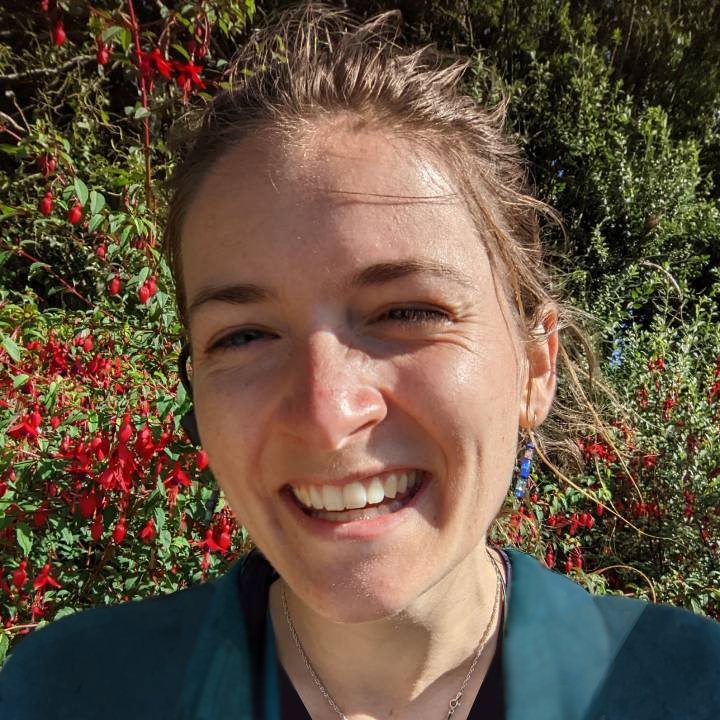
My name is Olivia Cannon, and I am entering my final year of a PhD at the University of Minnesota, working with Arnd Scheel. (Yes, I will be on the postdoc market this fall!). I did not go into college expecting to do mathematics, nor did I go into graduate school expecting to do dynamical systems, but I have found so much joy here.
Research
Roughly speaking, my research interests lie in pattern formation and coherent structures, which might be described as the study of structured states within systems which do not obviously possess this structure themselves. I enjoy using a combination of geometric intuition from dynamical systems, and functional-analytic tools.
My PhD work has focused especially on spatially extended nonlocal systems, in which the change in the system depends on the state of the system arbitrarily far away. Nonlocal systems arise in biology, neuroscience, social dynamics, materials science, population dynamics, marching bands, and more, and the key feature is that long-range connections are important in determining how they behave.
In the vein of coherent structures, studying patterns close to onset in these systems lends itself to methods including spatial dynamics, where keeping time constant allows \(x\) to be considered a time-like variable, and center manifold theory. Traditionally, nonlocal equations are not amenable to spatial dynamics due to the fact that the spatial operators are not classical differential operators. Recently, my advisor and I have extended work developed in [3] that allows nonlocal equations to be treated with these methods [2]. (See https://dsweb.siam.org/The-Magazine/Article/shifting-consensus-in-a-biased-compromise-model for an example [1]) In the same work we also prove a Lyapunov-Center theorem for a class of nonlocal equations. Such a theorem says that given a condition analogous to reversibility, one can conclude oscillations for the full nonlinear equation from oscillations in the linear part. Further, if there is exactly one simple pair of imaginary eigenvalues and existence of a center manifold, in fact, all small bounded solutions will be periodic.
I have also had the privilege of mentoring for the UMN Complex Systems REU in 2020 and 2022, where I was involved in projects on synchronization in spatially extended networks, and on bias and compromise in social dynamics (see https://dsweb.siam.org/The-Magazine/Article/shifting-consensus-in-a-biased-compromise-model). These projects have each gifted me extended curiosities in their respective topics, and I am curious to explore both for projects in the future.
Presently, I am working on a nascent project from the 2023 Mathematics Research Community on Complex Social Systems, investigating pattern formation in population aggregation, as well as work with my advisor on contact angle selection in weakly quenched fronts.
Teaching and Communication
A particular joy in graduate school for me has been teaching, and communicating mathematics in general. I have had the experience of teaching a number of the calculus and differential equations courses at UMN, both as a teaching assistant and lecturer, but one of my absolute favorite experiences was getting to be instructor of record for 'MATH 1001', a course called "Excursions in Mathematics." It is designed for non-math majors, and is a delightful mix of useful and playful mathematics. I want students of all kinds to feel that they are capable of doing math, and that "doing math" is a creative and descriptive process. Seeing students who had had negative experiences with math grow confident, and learn processes which were in my opinion objectively hard, was deeply exciting, and I want to continue to work on improving access to mathematics for all students.
Mentorship/Community
When I started doing math, I did not expect a warm and vibrant community to be one of the prominent features of the discipline. From the unique department at Bowdoin, to the bright graduate culture at University of Minnesota, to the research community within dynamical systems and pattern formation, community has been a deep theme of my mathematical life so far. I would not even be in mathematics had professors not persistently encouraged me to do so, and I feel convinced now that strong mathematics comes from vibrant community.
From being involved with the Mathematics Project at Minnesota, coming up with crazy (and serious) events for our AMS Student Chapter, mentoring for the Directed Reading Program, helping run Saturday Morning Math for middle schoolers, and more, I have been so grateful to be a part of the department at the University of Minnesota. I look forward to someday joining other departments and communities, learning their traditions, and maybe even making more.
When Not Doing Math
When convolutions are not on my mind, I can most likely be found at church, Nordic skiing, climbing something, riding a wheeled device around a lake at sunset, or some combination of the above. If you do any of these or related things, I would likely take joy in doing them with you.
References
[1] O. Cannon, T. Bondurant, M. Whyte, and A. Scheel, Shifting consensus in a biased compromise model, 2023.
[2] O. Cannon and A. Scheel, Coherent structures in nonlocal systems - functional analytic tools, 2023.
[3] G. Faye and A. Scheel, Center manifolds without a phase space, Trans. Amer. Math. Soc., 370(8), 2018, pp. 5843-5885.